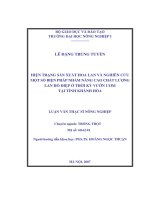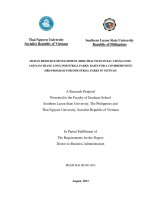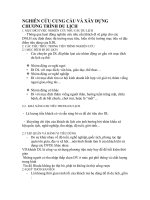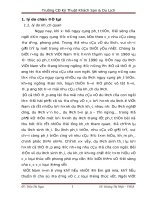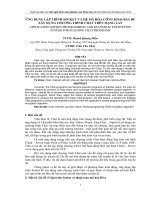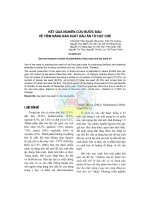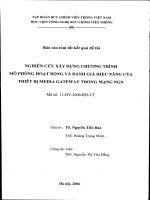Nghiên cứu và dự đoán tiềm năng phát triển của giảng viên dựa trên các đặc tính nghiệp vụ và hồ sơ cá nhân làm cơ sở xây dựng chương trình phát triển đội ngũ giảng viên
Bạn đang xem bản rút gọn của tài liệu. Xem và tải ngay bản đầy đủ của tài liệu tại đây (1.25 MB, 130 trang )
PERSONAL PROFILES OF THE ACADEMIC STAFFS AS PREDICTORS
OF PROFESSIONAL CHARACTERISTICS: BASIS FOR
STAFF DEVELOPMENT PROGRAM
A Dissertation Presented to the
Faculty of International Graduate School
Southern Luzon State University, Lucban, Quezon, Philippines
In Collaboration with
Thai Nguyen University, Socialist Republic of Vietnam
In Partial Fulfillment of the
Requirements for the Degree of
Doctor of Philosophy in Education Management
LAI VAN CHINH – (TERRY)
April, 2014
i
APPROVAL SHEET
The Dissertation of
LAI VAN CHINH
entitled
PERSONAL PROFILES OF THE ACADEMIC STAFFS AS PREDICTORS
OF PROFESSIONAL CHARACTERISTICS: BASIS FOR
STAFF DEVELOPMENT PROGRAM
Submitted in Partial Fulfillment of the
Requirements for the Degree
Doctor of Philosophy in Educational Management
In the Graduate School
Southern Luzon State University, Republic of the Philippines
in collaboration with
Thai Nguyen University, Socialist Republic of Vietnam
has been approved by the Committee
_____________________ ______________________
Member Member
______________________ ______________________
______________________
Chairman
DR. CONRADO ABRAHAM DR. APOLONIA A. ESPINOSA
Adviser Dean, Graduate School
Accepted in partial fulfillment of the requirements for the degree
Doctor of Philosophy in Educational Management
WALBERTO MACARANAN, Ed. D
Vice President, Academic Affairs
_____________________
Date
ii
ACKNOWLEDGMENT
The researcher wishes to extend his most sincere gratitude to the following people,
who in one way or another, made this piece of work a reality:
Dr. Cecilia N. Gascon, President of Southern Luzon State University, Republic of the
Philippines, who made possible the linkage with Thai Nguyen University and the offering of
Doctor of Philosophy in Educational Management, through the ITC-TUAF;
Dr. Dang Kim Vui, President of Thai Nguyen University, who developed the linkage
with Southern Luzon State University, Republic of the Philippines and the offering of Doctor
of Philosophy in Educational Management, through the ITC-TUAF;
Dr. Conrado Abraham, his research adviser, for his support and supervision
throughout his graduate study program. His advice and support during the conduct of his
study has greatly helped him a lot;
Prof. Nordelina Ilano, Director, Office for International Affairs of SLSU for her
outright assistance to the Ph.D. students;
Dr. Tran Thanh Van, the Dean of the Graduate School of Thai Nguyen University, for
his assistance and encouragement to pursue this study;
Dr. Dang Xuan Binh, the Director of International Training Center, for his
indefatigable effort to encourage the Ph.D. students to pursue this study;
To all the SLSU and TNU Professors, who unselfishly shared their time and
knowledge throughout the graduate studies in Thai Nguyen University, Vietnam;
Special thanks to his family and friends for their support, encouragement for being
the sources of greatest inspiration, which made his career a success.
Lai Van Chinh
iii
TABLE OF CONTENTS
TITLE PAGE Page
APPROVAL SHEET i
ACKNOWLEDGMENT ii
TABLE OF CONTENTS iii
LIST OF TABLES v
LIST OF FIGURES vii
LIST OF APPENDIX viii
ABSTRACT ix
CHAPTER
1 INTRODUCTION…………………………………………………………… 1
Background of the Study 3
Objectives of the study 6
Hypothesis of the Study 6
Significance of the Study 7
Scope and Limitation of the Study 7
Definition of Terms 8
2 REVIEW OF RELATED LITERATURE. . . . . . . . . . . . . . . . . . . . . . . . . .12
Review of Related Literature 12
Reserch paradigm 30
3 METHODOLOGY……… … 32
Locale of the Study 32
Research Design 33
Respondents of the study 33
Research Instruments 33
iv
Data Gathering Procedures 34
Statistical Treatment 34
4 RESULTS AND DISCUSSION 37
5 SUMMARY OF FINDINGS, CONCLUSIONS
AND RECOMMENDATIONS 61
Summary 61
Findings 61
Conclusions 63
Recommendations 65
BIBLIOGRAPHY 66
APPENDIX 70
CURRICULUM VITAE 116
v
LIST OF TABLES
1. Scale of values
2. Frequency and Percentage Distribution of the Respondents' Profile in Terms of
Age
3. Frequency and Percentage Distribution of the Respondents' Profile in Terms of
Gender
4. Frequency and Percentage Distribution of the Respondents' Profile in Terms of
Civil status
5. Frequency and Percentage Distribution of the Respondents' Profile in Terms of
Highest Education attainment
6. Frequency and Percentage Distribution of the Respondents' Profile in Terms of
Length of service
7. Frequency and Percentage Distribution of the Respondents' Profile in Terms of
Monthly income
8. Frequency and Average Weighted Mean of the Respondents' Profile in Terms of
working attitude
9. Frequency and Average Weighted Mean of the Respondents' Profile in Terms of
Mastery of the Subject Matter
10. Frequency Average Weighted Mean of the Respondents' Profile in Terms of
Pedagogical Ability
11. Frequency and Average Weighted Mean of the Respondents' Profile in Terms of
Scientific Research Ability
12. Average Weighted Mean Frequency and Percentage Distribution of the
Respondents' Profile in Terms of Ability of supplying social services
13. Frequency and Average Weighted Mean of the Respondents' Profile in Terms of
Ability of Ability of self-developing
14. Correlation of the professional characteristics in terms of age of respondents
15. Correlation of the Professional characteristics in terms of respondents’ Gender
16. Correlation of the Professional characteristics in terms of respondents’ civil status
17. Correlation of the Professional characteristics in terms of respondents’
Educational attainment
18. Correlation of the Professional characteristics of respondents in terms of length
36
38
39
39
40
41
41
42
44
45
46
47
48
49
50
50
51
vi
of service
19. Correlation of the Professional characteristics of respondents in terms of Family
income
20. Correlation between Age with Professional characteristics
21. Correlation between gender with Professional characteristics
22. Correlation between civil status with Professionals characteristics
23. Correlation between Educational attainment with professional characteristics
24. Correlation between length of service with professional characteristics
25. Correlation between family income with professional characteristics
52
52
53
53
54
55
55
56
vi
LIST OF FIGURES
1. Research paradigm. 30
2. Location of Hong Duc university in Thanh Hoa Province 32
vi
LIST OF APPENDIX
Appendix Page
A Correlation of the professional characteristics in terms of respondents
(Multiple regressions and Chi – Square) 70
B Questionnaire for academic staff 108
Title:
PERSONAL PROFILES OF THE ACADEMIC STAFF
AS PREDICTORS OF PROFESSIONAL
CHARACTERISTICS: BASIS FOR STAFF
DEVELOPMENT PROGRAM
Researcher:
Lai Van Chinh
Degree Doctor of Philosophy, Development Education
Nam/ Address of the
Institution
Southern Luzon State University
Graduate School
Lucban, Quezon
Date Completed April, 2014
Adviser
Dr. Conrado Abraham
ABSTRACT
This study was conducted to determine the personal profiles of the academic staff as
predictors of professional characteristics: Basis for staff development program of Hong Duc
University. It is the main objective of this study to determine if the Personal Profiles is a
predictor of Professional Characteristics of the Academic Staff of Hong Duc University.
Specifically, this research work sought to find out the personal profiles of the academic staff
of Hong Duc in terms of age, gender, civil status, .educational attainment, .length of service,
ix
and .family income; to determine the professional characteristics of the academic staff of
Hong Duc University as perceived by the respondents in terms of working attitudes, mastery
of the subject matter, pedagogical ability, ability to conduct scientific researches, ability to
conduct extension services, ability of supplying social services, and ability to self-
development. Furthermore, it was conducted to find out the significant differences between
the perceptions of the respondents when grouped into profiles; identify which of the profile of
the respondents predict professional characteristics of the academic staff of Hong Duc
University; and to propose an enhancement program based from the results of the study.
This study used the descriptive correlation design in analyzing the investigated
variables. A total of 508 teachers from different department of Hong Duc university were
requested to answer the questionnaire. They were randomly selected using the fish bowl
technique. Weighted mean was utilized to describe the leadership styles of principals. Chi-
square test was used to determine the significant relationship of the instructional variables and
leadership styles of principals. Multiple regressions were used to find out the predictability of
the influence of instructional variables to staff development program. The statistical analysis
was done using the Statistical Package for Social Sciences (SPSS), now also known as
Predictive analysis software.
Based on the results of the study, the following were the findings:
The frequency distribution of the respondents’ profile in terms of age, gender, and
civil status show that that most of staff’ age in Hong Duc University including teaching and
non-teaching were ranging from 31-40 years old in which catered 43.3 percent of the whole
distribution and the lowest was from age ranging 21-30 years old with 23.2 percent. And there
were age range that was near the retirement age which 56 and above that catered only 7.5
percent. While, in terms of gender, it shows that most of the Hong Duc University Staff were
male which catered 42.5 percent of the whole distribution and female respondents catered the
rest 57.5 percent in which a clear indication of the university professor in Hong Duc did not
x
show too much difference in the number of managers and professors who can manage and
teach in college or university. And in terms of status, it shows that most of the respondents
were married which catered 89,8 percent of the whole distribution.
In terms of the frequency distribution of the respondents’ profile on their highest
educational attainment, it shows that most of the academic staff or professor/lecturer in Hong
Duc University have at least attained their master’s degree which catered 46.3 percent with a
minute difference in the academic staff who are stagnant with their bachelor degree which
catered 41.5 percent. And 12.20 percent catered only the academic staff who have attained
their doctorate degree.
In terms of income levels for academic staff, those who have worked over 10 years is
very stable, they have at least an income of 5000.000đ per month which is enough for
ensuring their lives and families. However, the number of new employees under 10 years
which was rated at 11.4% have low-income.
Considering the professional characteristics of the respondents in terms of working
attitude, it shows that the academic staff of the university of Hong Duc were very good in
Having a good lifestyle and behavior, being a role model for students of the school where
they are working with mean score of 4.88. And they were also very good in Being ambitious
and keen on teaching and researching of the school with mean score of 4.86. But, they were
only good in protecting, defending and implementing the rules of ethnic teacher with mean
score of 3.43.
The professional characteristics of the respondents, in terms of mastery of the subject
matter, shows that they are good in Basic and Specialized knowledge with mean score of 3.84;
Knowledge of the policy and guidelines of the Viet nam Communist Party with mean score of
3.94; and Methods of testing and evaluating the results of students with mean score of 3.80; But
on the other hand, they were weak in the Knowledge of management and international integration
with mean score of 3.2.
xi
The professional characteristics of the respondents in terms of pedagogical ability
shows that the average rate of the competency assessment criteria of Hong Duc University
reached 3.46% which is very high although a few are still under average on Ability of
organizing, monitoring and getting feedback, evaluating from students; while 3,05, 39
lecturers are under average in Deploying educational programs and organizing scientific
research activity ability and 3,27, 46 lecturers are under average
It is reflected in the findings that the scientific research capabilities of lecturer of Hong
Duc University is still weak with an average of 3.38%, in which: Ability of collecting and
processing data and information: 3,20; Ability of writing reports and stating research results,
defending views and scientific thesis: 3,24 và năng lực về Ability of organizing scientific
workshop and giving feedback to scientific works: 3,19.
The ability to provide social services is not high, with the Weighted Mean Average
rate of 3:47%, but there are still some criteria at the average level, which is the ability of
supplying various services for society: 3.16; and in the ability to Conduct mission services for
the society: 3.14.
In summary, the assessment of content quality and capacity of the academic staff
revealed low in meeting or complying with the tasks leading to innovative and comprehensive
higher education as a response to Resolution 14/2006/NQ - CP of the Government on faculty
development for local universities.
1
CHAPTER I
INTRODUCTION
Nowadays, universities focus on building and developing core competencies and
distinctive competence of lecturers to create sustainable and long-term competitive advantage
that also enhance socio-economic needs of the country. It is in this context that the
government has established a comprehensive educational system which is envisioned to make
citizens literate, socially responsible, useful and law-abiding. A very significant factor in
education in this country is the fact that the government has taken the responsibility of
educating the citizenry.
The learner is the most important component in the educative process and so he is the
center of attention in the whole educational system. Hence, considering that the learner is the
center in the training process, he must be provided with the knowledge in accordance with the
times and the demands of the market. In view of this, Vietnamese universities in general and
local universities in particular should take full advantage of local opportunities. They should
overcome challenges, meet the elevation and development of higher education in the
knowledge economy, which will contribute to the social development needs and demand of
reaching up international level and joining the integration process.
As stated in Article 9 of Education Law of Vietnam, educational development is the
first national priority with a view to improving people’s knowledge, training manpower, and
fostering talents. Educational development must be linked with the requirements of socio-
economic development, to the scientific-technological advances, and to the consolidation of
national defense and security, must ensure the balance in terms of qualifications, professional
and regional structure, must expand scale on the basis of quality and efficiency assurance, and
must link education with employment.
The teacher, therefore, is a key player in the teaching-learning situation and he must
be a model to all his learners in all aspects of life. Learners are good imitators and they
2
usually make their teachers their role models. It is a fact that the teacher is the manager of the
teaching-learning activity, the facilitator of learning, and the evaluator of the learner’s
achievements.
Compared with other countries in Asia, Vietnam has the advantage of a large and
young population whose potential should be tapped in order to fulfill the 2020 development
vision. The literacy rate is over 90 percent and evidence of the significant efforts to date by
the government to develop human resources. In the coming years, key measures to promote
education and training include improving education quality through the introduction of
standards for learning outcomes, teacher performance, institutional capacity, and the
implementation of an effective education management.
Taking into account that the objectives of higher education in Vietnam are to educate
learners in acquiring political and moral qualities, endeavor to serve the people, professional
knowledge and practical skills relevant to the educational levels, and physical health, meeting
the needs of construction and defense of the country, teachers in various learning institutions
are expected to have modern and developmental characteristics, ensuring a rational balance
between basic knowledge and professional knowledge up to the international and regional
levels.
Moreover, guided by reality that it is the requirement of the government in the higher
education must guarantee students basic scientific knowledge and relatively complete
professional knowledge, scientific working methodology and the ability to apply theory into
professional activities, development of lecturers is a key role in ensuring the quality of
education.
Recognizing the crucial issue of higher education for organization -modernization
progress of the country, the Government of Vietnam (2005) issued Resolution 14/2005/NQ-
CP to approve the project “renovate basically and comprehensively Vietnamese higher
education in the period of 2006 – 2020”; with the desire of promoting a higher education
3
system toward more research and to move closer to international quality standards. There are
20 local universities, most of which are upgraded from colleges. Pressing issue which relates
directly to renewal request of higher education in the local and the region is predicted to solve
the shortcomings of lecturer development both in quantity, structure and quality.
Background of the study
Thanh Hoa province has an area of 11.106,09 km2 . It is situated on the top of the
north central in Vietnam. It is 150 km from Hanoi in the direction of the north, and 1.560
miles from Hochiminh city in the direction of the South.
Thanh Hoa has borders with Son La, Hoa Binh and Ninh Binh provinces in the north,
with Nghe An province in the south, Laos Hua Phan province in the west and Tonkin Bay in
the east. Thanh Hoa has 102 km coastline.
Thanh Hoa is the gateway, which connects the North and the Central and the South of
Vietnam.
Thanh Hoa’s population is over 3.700.000 people, There are 7 ethnic groups living in
Thanh Hoa, Kinh’s people takes mainly 84.75%, Muong people takes 8.7%, Thai’s people
takes 6.0% and the others such as H’Mong, Dao, Tho, Hoa.
Hong Duc University is a public university with multi-disciplinary, directly under the
People's Committee of Thanh hoa province and managed by the Ministry of Education and
Training. The University was established under Decision 797/TTg dated 24/9/1997 of the Prime
Minister on the basis of three schools: College of Education, College of Engineering-Economics
and Thanhhoa Medical College. Medical Department was separated and established to Medical
College in October 2004.
For more than 15 years of construction and development, Hong Duc University has
provided training human resources and has entered into joint training to provide a large
number of human resources with levels of universities, colleges and the lower ones of the
pedagogy, science, economics; business administration and informatics technology;
4
agriculture, forestry and fisheries; construction, mechanics; electronics-telecommunications
and electricity. Aside from the training task, the University has constantly improved the
quality of scientific research to serve the socio-economic development in the process of
industrialization and modernization of Thanh hoa province and neighboring areas.
The university has recruited, trained and fostered lecturers and managers; enhanced
facilities and equipment to improve the quality of training; promoted the scientific research
and international relationships; strengthened measures of comprehensive education for
students; expanded training industries to meet the growing social needs with higher quality.
In the industrialization-modernization cause, educational industry not only has many
new opportunities but also faces to challenges. The immediate and long-term task of Hong
Duc University is to train staff who have qualities, qualifications and professional skill to
meet developed requirement of the province and the country.
Hong Duc University with the educational system in Thanh hoa has become the main
factor which meets the training needs of local human resources to contribute to the successful
implementation of the XVI Resolution Party Congress which is emphasized on the following
objectives to "develop human resources, apply scientific and technological achievements, and
promote educational socialization". Moreover, the university strives to meet the training needs
of growing high-quality human resources of the region and the country with the mission of a
university in the national education system and the network of the country's universities.
The development of the university and the ability of integration into the educational
system of the country, region and world entirely depend on the determination of objectives,
key tasks; selection of appropriate steps and specially, the positive solutions to improve the
quality of training. For over 15 years, the university has identified that the training and
scientific research are two key tasks throughout the development process. Nowadays, standing
in front of the requirements of international integration, with the two tasks the university
5
determines that international integration is a very important task because it is a condition for
the university to reach the goal of continuously improving quality of training.
The mission of the university is to train human resources for socio-economic development
strategy of the country in general and Thanhhoa in particular, and be consistent with each period.
In the network of higher education, Hong Duc University plays an important role in training of
human resources for socio-economic development strategy of local, contributing significantly to
meeting the needs of society. The university is considered as the leader in the network of
universities, colleges, professional secondary schools and vocational colleges in Thanhhoa in:
training, scientific research, advisory for making policies of socio-economic development of the
province, is the trust address in the educational system of the province.
However, reports in the past three (3) years revealed that the quality of the academic
staff failed to meet the requirements of the University in terms of personnel profiles. It
somehow affects the development and reputation of the University.
The percentage of staff and lecturer with the doctoral level is low as observed in the
different discipline which did not conform on the standard staff requirements. The foreign
language of staff and lecturers is limited. Managers are mostly part-time lecturers who have not
been basically trained about the management science. Shortage in the structure of lecturers are not
solved, the percentage of leading lecturers does not meet the qualification standards in terms of
educational qualifications with the doctoral and master’s level, as the requirements for the higher
education.
With this premise, it is in this context that there is a need to determine the personal
profiles of the academic staff as predictors of professional characteristics which will serve as basis
for the improvement of the quality of higher education and trainings.
Objectives of the Study
It is the main objective of this study to determine if the Personal Profiles is a predictor
of Professional Characteristics of the Academic Staff of Hong Duc University.
6
Specifically, this research work sought to:
1. Find out the personal profiles of the academic staff of Hong Duc University in terms of:
1.1. age
1.2. gender
1.3. civil status
1.4.educational attainment
1.5.length of service
1.6.family income
2. Determine the professional characteristics of the academic staff of Hong Duc University as
perceived by the respondents in terms of:
2.1. Work attitudes
2.2. Mastery of the subject matter
2.3 Pedagogical ability;
2.4 Ability to conduct scientific researches;
2.5 Ability of supplying social services; and
2.6 Ability to self-development.
3. Find out the significant differences between the perceptions of the respondents when
grouped into profiles.
4. Identify which of the profile of the respondents predict professional characteristics of the
academic staff of Hong Duc University.
5. Propose staff development program based on the results of the study.
Hypotheses:
1. None of the profile of the respondents predict their professional characteristics.
2. The perceptions of the respondents when grouped as to profile have no significant
difference.
Significance of the Study
7
The researcher firmly believes that the result of the study could be beneficial to the
following:
For the teacher. To make the necessary adjustments in line with the lecturers
development program thereby improving their personal growth.
For the staff. To serve as guides in understanding the current picture of the
organizational staff, its developments and impacts on Thanh Hoa province tertiary education,
based on theories of developing the teacher staff to meet requirements for tertiary education
renovations.
For the Heads and officers of offices. The results of this study would encourage
school officials to workable plan on the staff development program in the university.
For the University. Coming up with principles for selecting solutions and
recommending some action plans in developing a functional staff development program of
Hong Duc university to meet requirements for fundamental and comprehensive renovation of
Vietnam tertiary education.
For Future researchers. This study will serve as reference on other areas of
manpower development to further improve personnel profile.
Scope and Limitation of the Study:
This study is limited to the academic staff of Hong Duc University in Thanh Hoa
province and focused on contents of staff development program.
Survey Situation of lecturers, activities of staff development in Hong Duc University
in Thanh Hoa province, covers mainly from 2005 to 2010, and then studying and building
strategies for development of lecturers in Hong Duc University for a duration of five (5)
years, from 2014-2019.
Definition of terms
For clarity and better understanding of the study, the following terminologies are
defined both conceptually and operationally.
8
Age refers to the age of the respondents when the study has been conducted.
Educational attainment Is an achievement or the act of achieving; accomplishment.
Educational attainment refers to the highest educational qualification or academic degree that
a school leader has obtained.
Gender Is used to describe the characteristics, roles and responsibilities of women and
men, boys and girls, which is socially constructed. Gender refers to the personal sexual
identity of a school leader, regardless of his/her biological and outward sex.
Length of management experiences refers to the duration of time that a school leader
has held a management position.
Length of service refers to the duration of time that a school leader has been working in
a school.
Marital status refers to the conjugal status in relation to marriage laws of a school
leader in Vietnam.
Monthly income refers to the total amount of money a school leader has earned in a
month.
Ability to conduct scientific research. It refers to the capability to undertake
researches, collect and process data and information, analyze and interpret research results,
and write reports.
Ability of supplying social services. It refers to the capability on how the goals and
activities in school relate to the values and aspirations in the learners’ home and communities.
In addition, the teacher can draw from resources, ideas and activities from the learners’
communities in the teaching – learning situations.
Ability to self-development. It refers to the personal growth and professional
development which emphasizes the ideal that teachers value having a high personal regard,
concern for professional development, and continuous improvement.
9
Academic staff . It refers to the teachers and lecturers, including the senior teachers,
lecturers, and/or researchers. The term generally includes professors of various ranks:
assistant professors, associate professors, and (full) professors, usually tenured (or tenure-
track) in terms of their contract of employment.
Members of university administration (e.g., department chairs, deans, vice presidents,
presidents, and librarians) are often also faculty members, in many cases beginning (and
remaining) as professors. In some universities, the distinction between 'academic faculty' and
'administrative faculty' is made explicit by the former being contracted for nine months per
year, meaning that they can be absent from the campus during the summer vacation, while the
latter are contracted for twelve months per year. These two types of faculty status are
sometimes known as 'nine month faculty' and 'twelve month faculty'.
Most university faculty members hold a Ph.D. or equivalent doctorate degree. Some
professionals or instructors from other institutions who are associated with a particular
university (e.g., by teaching some courses or supervising graduate students) but do not hold
professorships may be appointed as adjunct faculty.
Other than universities, some community colleges and secondary or primary schools
use the terms faculty and professor to describe their instructors, but this does not hold the
same status as a professor in a university. Other institutions (e.g., teaching hospitals) may
likewise use the term faculty.
Development of lecturer staff. Development of lecturer/ staff in University is a
perfect process or continuously changes the existing situation in order to help the team grow
in all aspects by providing corresponding professional trainings
Lecturers. Teachers who do the task of teaching and education in schools and other
educational establishments. Teachers who teach in higher education establishments are called
lecturers.
1
Lecturer staff. Lecturer staff is a collection of people as teachers, scientists,
organized into a team who do together a task. That is to implement the training objectives
which set out in the universities and colleges.
Mastery of the subject matter. It refers to the ability of the teacher to deliver
accurate and updated content knowledge using appropriate methodologies, approaches and
strategies. (conceptual definition)
Pedagogical Ability. It refers to educating and teaching according to educational
objectives, principles and curriculum, with pedagogical university degree of pedagogy
training. (Education Law of Vietnam, 2010)
Professional development. It refers to formal types of vocational education, typically
post-secondary or poly-technical training leading to qualification or credential required
obtaining or retaining employment. Professional development may also come in the form of
pre-service or in-service professional development programs. These programs may be formal,
or informal, group or individualized.
Staff development. It includes everything that is done to maintain and extend the
knowledge and skills of staff so that they can contribute fully towards the achievement of goals
of the University. Academic staff development supports the personal and professional
improvement of academic staff, as well as the organisational development needs of the
University. Of particular importance for academic staff are continuous development of teaching
and research skills, and maintaining currency in the disciplines on which the University’s
programmes are based.
Staff development is relevant to all staff and the whole person;
All academic staff are expected to participate in staff development activities aimed at
improving the University’s academic excellence and the effectiveness and efficiency of its
operations;
1
Staff development should draw on the skills and knowledge of staff as much as
possible;
Reflection, review, feedback and opportunities for learning should form an integral
part of everyone’s work experience.
Strategy: It is a high level plan to achieve one or more goals under conditions of
uncertainty. Strategy becomes ever necessary when it is known or suspected there are
insufficient resources to achieve these goals. Strategy is also about attaining and maintaining
a position of advantage over adversaries through the successive exploitation of known or
emergent possibilities rather than committing to any specific fixed plan designed at the outset.
(Internet Wikipedia)
Strategic HRM: The process involved in directing people, processes and HR systems
to achieve strategic objectives that will tie in individual goals to the business needs of the
whole organization. (Internet Wikipedia)
Strategic plan: Strategic planning is an organization's process of defining its strategy,
or direction, and making decisions on allocating its resources to pursue this strategy. In order
to determine the direction of the organization, it is necessary to understand its current position
and the possible avenues through which it can pursue a particular course of action. Generally,
strategic planning deals with at least one of three key questions. (Internet Wikipedia)
Work Attitude. Refers to being exemplary in the fulfillment of civic duties,
regulations of law and school charters; maintaining moral quality, prestige and honor,
respecting learners’ dignity, to reat learners equally, and protect legitimate rights and interests
of learners. (Education Law of Vietnam, 2010)
1
CHAPTER II
REVIEW OF LITERATURE AND STUDIES
This chapter presents the review of related literature and studies which the researcher
finds closely related to the present study, especially the topics concerning staff development
programs.
Professional Characteristics of Teachers
A. Work Attitude
The teacher is the manager of the teaching-learning situation, the facilitator of
learning, and the evaluator of the learner achievement. Hence, he must possess the following:
(1) Has a good lifestyle and behavior, and a role model for students; (2) Respects the
standards, behaviours and rules; (3) Maintains and builds a good reputation; (4) Creates a
healthy and free expression of ideas; (5) Provides timely and accurate feedback for the
learners to reflect on; and (6) Facilitates learning of diverse type of learning environment.
Bigge (2004).
In view of this, higher education provides conditions favorable to good teaching and
effective learning. This should consider the people and its efficiency to measured the extent to
which they contribute to teaching-learning situation. These can contribute immensely in
providing efficient teachers and furnishing them and the students with proper tools and
environment for work. Moreover, these imply to the improvement of the total teaching-
learning situation and the conditions that affect them.
Based on the publication of Đoan Van Đieu (2013) in Journal Science of Ho Chi
Minh City University of Education about Some instructors’ virtues which are based on the
evaluation by students at Ho Chi Minh City University of Education: The article is about a
survey on the evaluation of the qualities (positive and negative) of instructors – the general
ones, the ones for teaching, and the ones for education by students at Ho Chi Minh City
1
University of Education. The findings show that the qualities for teaching are ranked at the
highest level.
In “101 Great Ways to Enhance Your Career”, experts suggested the following:
encourage, inspire and guide your path to procure, maintain and actualize your career
objectives. On the other hand, Michelle A. Riklan and David Riklan (2009), claimed that the
most important thing to do as you begin your new career is to define your attitude towards
work. How will it contribute towards your career? How will it add value to your role as a
career builder?
One should understand that a positive attitude is even more important. So attitude
towards work means deciding the values that would guide workers in his working
environment.
There are three values of work attitudes towards career:
1. Pride. It connotes arrogance especially when one has too high an opinion of oneself.
So, "Pride" is taken to mean self-dignity. If you know everything you do at work which has
your name and signature on it, then you will give it your best shot and nothing less.
2. Passion. Just a simple plain ‘interest’ in any work or career you choose that isn’t
enough to bring you through the tough times. It is an intense enthusiasm for all things worth
doing that will put someone through the toughest times.
3. Belief. In order to generate that passion, it is important to believe. Only a deep
belief will create the vigour and force that gives someone the fuel to charge. As the saying
goes: “Know that you can achieve all that you set out to do for yourself. You only need to
start believing in yourself.”
As described by Riklan (2009), work attitude behavior is intangible, one can not just
see it, but people can feel it. People working in the group can feel the work attitude behavior
of others. They can feel wheather someone has carried out his tasks with pride. They can feel
